
The Fauna of British India with long titles including The Fauna of British India, Including Ceylon and Burma, and The Fauna of British India Including the Remainder of the Oriental Region is a series of scientific books that was published by the British government in India and printed by Taylor and Francis of London. The series was started sometime in 1881 after a letter had been sent to the Secretary of State for India signed by Charles Darwin, Sir Joseph Dalton Hooker and other "eminent men of science" forwarded by P.L.Sclater to R.H. Hobart. W. T. Blanford was appointed editor and began work on the volume on mammals.

William Lucas Distant was an English entomologist.

Platylomia is a genus of cicadas from Southeast Asia.
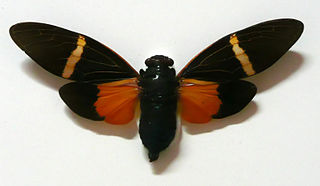
Tosena is a genus of cicadas from South-East Asia. They are the type genus of tribe Tosenini. Species formerly included in Tosena are Distantalna splendida, Formotosena montivaga, Formotosena seebohmi and Trengganua sibylla.
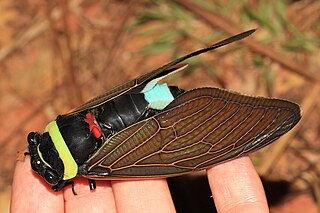
Tacua speciosa is a very large Southeast Asian species of cicada. It is the only member of its genus.

Gaeana is a genus of cicadas, most members of which have colourful marking on their forewings, found across tropical and temperate Asia. Their bright wing patterns have been hypothesized as being a case of Batesian mimicry where the toxic models may be day-flying moths of the subfamilies Zygaeninae and Arctiinae. It is closely related to the genus Tosena but is differentiated by the exposed tympanum and lacks spines on the sides of the pronotum.

Tosena depicta is a cicada species from Southeast Asia
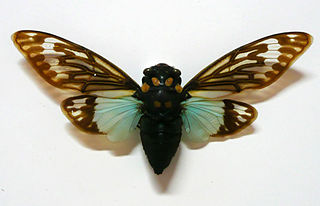
Distantalna splendida is a cicada species from Southeast Asia. It was previously placed in the genus Tosena. A characteristic that distinguishes Distantalna splendida from the Tosena species is the partly pale hyaline tegmina and wings. The species of Tosena do not have hyaline parts in the tegmina and wings. It has been recorded from India, Myanmar and Thailand.

Tosena albata is a cicada species from Southeast Asia. It was described by William Lucas Distant in 1878 who, however, subsequently regarded it as a variety of Tosena melanoptera. However, in 2000 Boulard confirmed the species status of Tosena albata by comparing its song with that of other Tosena species. T. albata has hitherto been recorded from Thailand, Nepal, North India, and Northwestern Himalaya

Tosena fasciata is a cicada species from Southeast Asia that has been recorded from Sumatra, Java, Borneo and Ambon Island

Tosena dives is a cicada species from Southeast Asia. The type was collected in Sylhet, Bangladesh. This species has also been recorded from Sikkim and Darjeeling in India.

Tosena mearesiana is a cicada species from Southeast Asia. It was described in 1842 by Westwood from a specimen originating from the Himalayas. It has also been recorded from Sikkim in India.
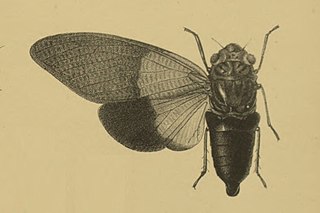
Trengganua is a cicada genus from Southeast Asia. The genus Trengganua was erected by Moulton to accommodate Trengganua sibylla, a species originally described by Stål and placed in the genus Tosena by Distant.

Trengganua sibylla is a cicada species from Southeast Asia. The species is recorded from Terengganu, Jelebu and Temengor Forest Reserve in Peninsular Malaysia. Trengganua sibylla typically sings around high noon.

Angamiana is a genus of cicadas from Southeast Asia

Graptopsaltria is a genus of cicadas from East Asia.
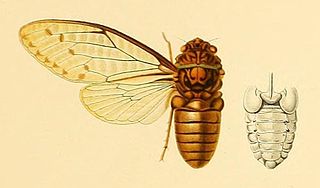
Leptopsaltria is a genus of cicadas from Southeast Asia.

Gaeana atkinsoni is a colourful cicada species and is the only member of the genus Gaeana that is found in southern India. Other species are found along the Himalayas and in Southeast Asia. It is endemic to the forests of the Western Ghats where it emerges in summer. Males are brightly coloured with a yellow and black forewing and a bright red hindwing that is visible in flight.
Psithyristriini is a tribe of cicadas in the family Cicadidae, found in the Philippines. There are about 7 genera and at least 100 described species in Psithyristriini.

Dundubia is a genus of cicadas in the subfamily Cicadinae and the type genus of the tribe Dundubiini.


















